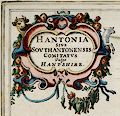
 Return to list of Features
Return to list of Features

NB: typical illustrated examples are described, NOT ALL examples.
absence of evidence is not evidence of absence

Marked by Southsea castle is:-
Telegraph


Telegraph [ENE of Wickham]
Bramshaw Telegraph
Telegraph [ESE side of Toothill]
Telegraph [on Portsdown N of Cosham]
Telegraph [by Charlton Windmill]

Labelled at the east end of Portsdown is:-
SemaphoreOn hengistbury Head there is a:_
Signal Housebut this is not part of the telegraph system.

South west of Bramshaw is labelled:-
Telegraph

SW of Bramshaw is:-
Telegraph

Some telegraphs are noticed. There is a:-
Semaphoreon Portsdown above Farlington. And south of the castle, on Calshot Spit is:-

Old Telegraph

The map shows telegraphs, closely associated with the railways, by hatching alongside the railway line with telegraph stations marked by hatching around the railway station's dot. These are electric telegraphs. Not all railway stations were telegraph stations. See for example the telegraph running alongside all the London and Southampton line, with telegraph stations at Basingstoke, Winchester, Bishopstoke (better known now as Eastleigh) and Southampton only. Some lines have no telegraph.
See:-

BASINGSTOKE STAwith the telegraph along the LSWR and the Berks and Hants lines, and a telegraph station.
The telegraph from near Brockenhurst Junction to Lymington follows the line of the road not the railway, going to a telegraph station in the town. This line continues independently of railway to Keyhaven and thence to Hurst Castle telegraph station, and across the mouth of The Solent to the Isle of Wight, and by land to an end telegraph station at Cowes.
See:-

at Lymington, and

at Hurst Castle.
The telegraphs mapped are electric telegraphs, the 'two needle' telegraph invented by Cooke and Wheatstone. Railways were probably the best customers for this then new form of communication. See:-

Wilson, Geoffrey: 1976: Old Telegraphs: Phillimore:: ISBN 0 900592 76 6

